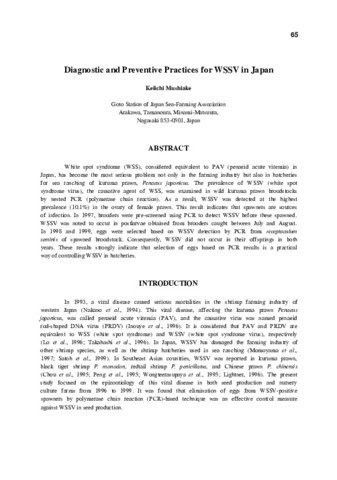Diagnostic and preventive practices for WSSV in Japan
Share
Abstract
White spot syndrome (WSS), considered equivalent to PAV (penaeid acute viremia) in Japan, has become the most serious problem not only in the farming industry but also in hatcheries for sea ranching of kuruma prawn, Penaeus japonicus. The prevalence of WSSV (white spot syndrome virus), the causative agent of WSS, was examined in wild kuruma prawn broodstocks by nested PCR (polymerase chain reaction). As a result, WSSV was detected at the highest prevalence (10.1%) in the ovary of female prawn. This result indicates that spawners are sources of infection. In 1997, brooders were pre-screened using PCR to detect WSSV before these spawned. WSSV was noted to occur in postlarvae obtained from brooders caught between July and August. In 1998 and 1999, eggs were selected based on WSSV detection by PCR from receptaculum seminis of spawned broodstock. Consequently, WSSV did not occur in their offsprings in both years. These results strongly indicate that selection of eggs based on PCR results is a practical way of controlling WSSV in hatcheries.
Suggested Citation
Mushiake, K. (2002). Diagnostic and preventive practices for WSSV in Japan. In Y. Inui & E. R. Cruz-Lacierda (Eds.), Disease Control in Fish and Shrimp Aquaculture in Southeast Asia - Diagnosis and Husbandry Techniques: Proceedings of the SEAFDEC-OIE Seminar-Workshop on Disease Control in Fish and Shrimp Aquaculture in Southeast Asia - Diagnosis and Husbandry Techniques, 4-6 December 2001, Iloilo City, Philippines (pp. 65-74). Tigbauan, Iloilo, Philippines: SEAFDEC Aquaculture Department.


